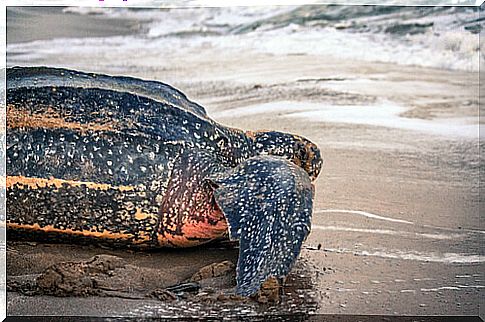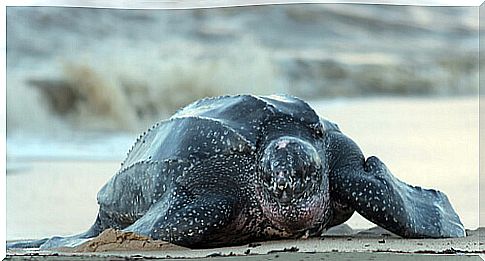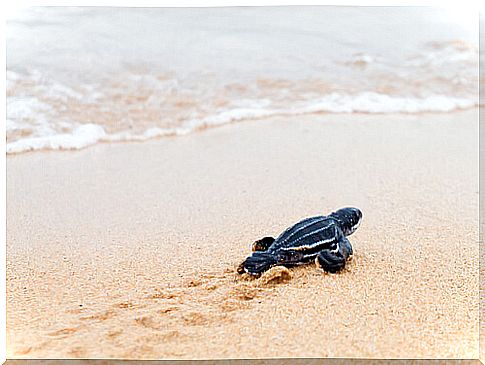Leatherback Turtle: Characteristics, Feeding And Habitat

The leatherback turtle is the largest of all the turtles that we know of. It travels all the seas, and perhaps that is why it has a shell with such a peculiar shape. Discover all the curiosities of this reptile below:
Leatherback turtle characteristics
The leatherback turtle is the largest of all known turtles: it can grow to be over two meters long and they think about 600 kilograms. Once a turtle was discovered that had reached almost 900, but it was an anomaly.
Like the rest of turtles, it belongs to the reptile family. However, it has a characteristic that is still a mystery: this animal manages to keep its body at a higher temperature than the outside. Reptiles depend on the outside temperature to regulate their body; Being able to generate your own body heat is typical of mammals.

Despite this, the most curious characteristic of the leatherback is its shell: normally, the exterior of the turtles is a hard shell made up of bony shields. However, the leatherback’s shell is soft, made up of a weave that may be reminiscent of leather.
For this reason, this turtle does not have a rounded shape with the edges of the shell and the breastplate well differentiated, as occurs with other relatives close to it. On the contrary, its body forms a smooth curve that tapers as the tail approaches : this curious shape is reminiscent of the lute, the musical instrument that gives it its name.
Leatherback turtle feeding
The leatherback turtle does not have teeth: its mouth is made up of a beak and its throat has wattles that help it swallow its prey. The diet of this animal is based mainly on jellyfish. They move throughout the entire planet looking for jellyfish to hunt, although if necessary they can also hunt small fish, crustaceans, squid and even algae.
The leatherback turtle eats a large number of jellyfish: it can eat its own weight per day. Therefore, these reptiles are very important to maintain ecological balance and control the size of jellyfish populations.
It is sadly common that human garbage is mistaken for food: plastics can look like jellyfish. Numerous dead leatherback turtles have been found with their stomachs filled with plastic bags, transparent string, or pieces of fishing nets.
Leatherback turtle habitat
They tend to be distributed in colder oceans than other species of turtles thanks to their ability to maintain their body temperature, and perhaps that is why they are also more distributed throughout the planet than the rest of their relatives. Except for the poles, they are present in all oceans.

During the summer months, leatherback turtles are most commonly seen off the coasts of North America, both in the Atlantic and the Pacific. When winter approaches, they migrate and concentrate in the warmer seas: the coasts of South America, while the European ones travel south, towards the center of Africa. Asian tortoises are concentrated around Indonesia and Australia.
However, these animals can change oceans throughout their lives. Turtles have been discovered that had been observed on one continent, and a few years later they were on the other side of the planet. We know that they orient themselves and that they make their trips thanks to the magnetic fields of the Earth.
They like to live and move quite deep above the surface of the sea: it is known that they can descend as low as 900 meters. It is capable of spending long periods of time submerged thanks to the fact that it is able to extract oxygen from the water that surrounds it in order to breathe.
Leatherback turtle conservation
Adult leatherback turtles are large animals that do not have predators, but the eggs and young are very vulnerable: few juveniles become adult specimens.

The greatest threat that affects the populations of these reptiles comes from human activity: one of them is the destruction or alteration of the beaches where the turtles lay their eggs and where the newly hatched young must find the sea.
For adult specimens, the contamination that causes them to ingest plastics, become poisoned or entangled and remain immobilized is the greatest threat. There are few cases of turtles colliding with ships.
The leatherback turtle is currently considered an endangered animal, but its situation is not worrisome. Despite this, it is known that its population does not stop decreasing and there are more and more problems that are faced: if a solution is not found for the pollution of the oceans, soon it will be necessary to launch urgent alarms.









